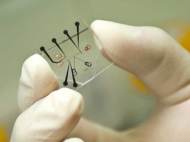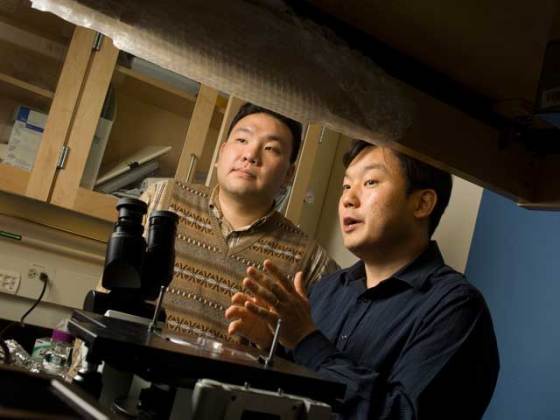MIT researchers develop a new approach for water desalination
 A new approach to desalination being developed by researchers at MIT and in Korea could lead to small, portable units that could be powered by solar cells or batteries and could deliver enough fresh water to supply the needs of a family or small village. As an added bonus, the system would also remove many contaminants, viruses and bacteria at the same time.
A new approach to desalination being developed by researchers at MIT and in Korea could lead to small, portable units that could be powered by solar cells or batteries and could deliver enough fresh water to supply the needs of a family or small village. As an added bonus, the system would also remove many contaminants, viruses and bacteria at the same time.
One of the leading desalination methods, called reverse osmosis, uses membranes that filter out the salt, but these require strong pumps to maintain the high pressure needed to push the water through the membrane, and are subject to fouling and blockage of the pores in the membrane by salt and contaminants. The new approach, called ion concentration polarization, separates salts and microbes from the water with the help of electrostatics – repelling them away from the ion-selective membrane in the system.
The system works at a microscopic scale, using fabrication methods developed for micro-fluidic devices (similar to the manufacture of microchips) for materials such as silicone (synthetic rubber). Each individual device would only process minute amounts of water, but a large number of them. The researchers expect an array with 1,600 units, fabricated on an 8-inch-diameter wafer, could produce about 15 liters of water per hour. Salt water would be poured in at the top, and fresh water and concentrated brine collected from two outlets at the bottom, so the whole unit could be self-contained and driven by gravity.
So far, the researchers have successfully tested a single unit, using seawater they collected from a Massachusetts beach. The water was then deliberately contaminated with small plastic particles, protein and human blood. The unit removed more than 99 percent of the salt and other contaminants. “We clearly demonstrated that we can do it at the unit chip level,” said Sung Jae Kim.
While the amount of electricity required by this method is actually slightly greater than for present large-scale methods such as reverse osmosis, the researchers claim there is no other method that can produce small-scale desalination with anywhere near this level of efficiency. If the proposed system is properly engineered, it would use about as much power as a conventional lightbulb.
Since the separation occurs electrostatically, it doesn’t work for removing contaminants that have no electric charge. To take care of these remaining particles (mostly industrial pollutants) the researchers suggest the unit could be combined with a conventional charcoal filter system, thus achieving pure, safe drinking water through a single simple device.
Having proved the principle in a single-unit device, Kim and his associates plan to produce a 100-unit device to demonstrate the scaling-up of the process, followed by a 10,000-unit system. They expect it will take about two years before the system will be ready to develop as a product.
“After that,” says Kim, “we’ll know if it’s possible” for this to work as a robust, portable system, “and what problems might need to be worked on.”










author
If your are a part of Nature Nanotechnology, you can read more in a paper by Sung Jae Kim, Sung Hee Ko, Kwan Hyoung Kang, and Jongyoon Han named “Direct Seawater Desalination by Ion Concentration Polarization”.
Though the method is good, what developing countries need is a cost-effective innovative but simple technology of water purification. I designed a Solar Disinfection Unit which is cheap and which utilizes local skills and local material.
The innovative solar disinfection system has a wooden frame of length 2 ft,width 1 foot
and depth 6 inches with bottom sinusoidal shaped polished stainless steel (curvature
slightly larger than standard glass wine bottles, about 5 inches diameter) . On the front is
fixed a glass sheet having lifting arrangement with a knob (this glass enclosure will
protect the glass bottles from cooling down due to outside wind). There are screws which
can be used to keep the contents airtight. On the backside a stand is fixed which will help
the unit to be placed according to the latitude of the place for maximum solar insolation.
In this method clear glass bottles (used wine bottles) are utilised instead of PET bottles as
the former are easy to clean, lasts longer and are available at a low cost in India. Solar
disinfection is more efficient in water containing high levels of oxygen; sunlight produces
highly reactive forms of oxygen (oxygen free radicals and hydrogen peroxides) in the
water. These reactive forms of oxygen kill the microorganisms. Aeration of water is
achieved by shaking the 3/4 water filled bottles for about 20 seconds before they are
filled completely.
The unit has an advantage in that the rear reflection stainless steel will pass the light
through the bottles a second time, to both increase exposure and eliminate shadowing.
This reflection system will increase the light intensity minimum 2 times.
It has been widely experimented and established by earlier researchers that at temperature
of 500C, pathogenic microbes are inactivated. The temperatures which cause
approximately a 1-log decrease in viability with 1 min are 550C for protozoan cysts; 600C
for E.coli, enteric bacteria, and rotavirus; and 650C for hepatitis A virus.
Operation
The unit is placed in the south direction (in India) around 10 am with inclination equal to
the latitude of the place. The glass bottles are filled with water three fourths and shaken
for 20 seconds to generate oxygen and then completely filled. The water filled bottles are
fixed with caps and put in the groves of the solar disinfection unit. The glass door is
closed and clipped airtight. Water bottles are removed from the unit at 3 pm and taken to
a cool place and the disinfected water transferred to a clean vessel, covered for later
usage.
Suspended particles in the water reduce the penetration of solar radiation into the water
and protect microorganisms from being irradiated. Solar disinfection requires relatively
clear water with a turbidity less than 30 NTU.To remove turbidity traditional methods of
putting the paste from seed of strichnos potatorum (Nirmal seeds) by rubbing the seed on
a rough stone with water is used. The method is effective, turbidity settles down in half of
an hour and the seed are available in plenty in forests in India besides being inexpensive.
A larger unit with polyethylene covering has also been designed and tested.
Extensive tests were conducted with waste water, well water, bore water etc., and 99.8% purification was recorded. This unit is expected to be a boon especially for rural areas in developing countries.
Dr.A.Jagadeesh Nellore(AP),India
this invention is very portable one
this is very useful for rural areas.i wish the inventors the best.